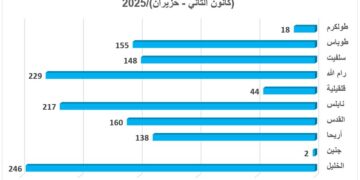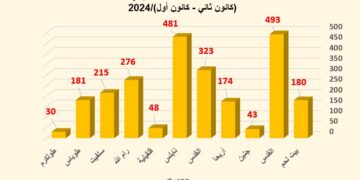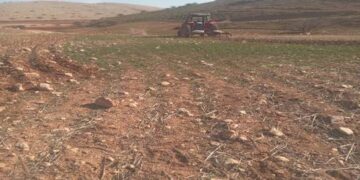On the 23rd of August 2011, the Israeli Settlers of Bat Ayin Settlement ravaged the lands and the agricultural fields of Wadi Abu Reesh in Biet Ummar. The settlers stormed the lands and ruined Olive trees, Plum trees, and vineyards in the agricultural fields, which belong to the Palestinians farmers in the area.
The targeted lands belong to the Palestinian resident Hammad A’bed-Al-Hameed Al-Sliebi, who explained in an interview how the Israeli settlers attacked his land of 40 dunums, and how they ruined five old roman trees, 25 vineyards, and 25 plum trees. The farmer stated that the settlers’ attack was not the first of its kind, explaining that similar attacks has happened at least four time before that and that trees were burned and uprooted. He also added that every time he filed a complain over the incident with the Israeli police, his complain would be dismissed and filed against “unknown” even though he would accuse the settlers but the police say that insufficient evidence and lack of name/s of the alleged perpetrator/s give them no room to pursue such complains.
The irony of the whole incident and others like it that take places throughout the West Bank is while the attacks are happening; the Israeli Army would be in close proximity, and with eyesight of the happenings but do nothing to stop such attacks since it existence at that location at the time would be to provide security cover for the settlers while they are attacking and destroying the fields and the only time they would intervene is when they feel the settlers are in danger, and that is when the local residents and the lands owners start to take action to stop the settlers.
The Israeli settlers’ of Bat Ayin Settlement have been targeting land of Beit Ummar and other lands of Palestinian villages in the settlement’s vicinity in an attempt to grab more lands and expand the settlement’s jurisdiction. Beit Ummar’s land has always been a favorite target for its rich fertile agricultural lands; specially that 60% of its annual total income comes from agriculture produces. Table 01 shows the list of the sources of agricultural income of Beit Ummar.
|
Table 01: list of the sources of agricultural income of Beit Ummar
|
|
Type
|
Quantity
|
|
Fruit trees
|
10324 dunums
|
|
Vegetables
|
456 dunums
|
|
Field Crops
|
301 dunums
|
|
Goats
|
2200 head
|
|
Sheep
|
6300 head
|
|
Poultry
|
208000 bird
|
|
Bee Hives
|
202 hive
|
|
Source: GIS Unit / ARIJ
|
The agricultural lands, the livestock constitutes a vital part of the people’s life in Beit Ummar; in fact for many the only source of income; hence, the sustainability of life for the Palestinians there, greatly depends on such way of life; something the Israeli settlers have realized, which is why they (the Israeli settlers) are on a mission to rid the Palestinians from whatever ties them to the land.
Beit Ummar- the Indigenous Community:
Beit Ummar is a Palestinian community – Town, located on the main road between Bethlehem and Hebron Governorates. It is located 10 Km north of Hebron city, and 15 Km south of Bethlehem. Its population exceeds 15000 Palestinians. Beit Ummar sets on a total area of 40150 dunums, of which 32% (13000 dunums) constitutes the built-up area.52% (21000 dunums) makes the agricultural/ cultivated lands, while some 4000 dunums (10%) were confiscated over different periods of time by the Israeli occupation to build settlements and for other uses “security” by the Israeli Army.
Bat Ayin- the Settlement:
A settlement that is known also as ‘Tzurif’; established in 1989. It accommodates more than 950 Israeli settlers, and today; it sets on a total land area of 700 dunums, which includes the settlement’s built-up area and other jurisdiction area reserved for future expansion of the Settlements.
Prepared by:














